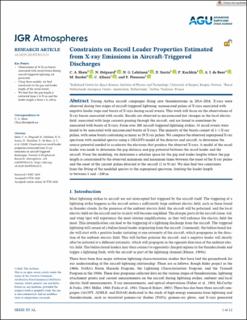| dc.contributor.author | Skeie, Chris Alexander Kallevik | |
| dc.contributor.author | Østgaard, Nikolai | |
| dc.contributor.author | Lehtinen, Nikolai | |
| dc.contributor.author | Sarria, David | |
| dc.contributor.author | Kochkin, Pavlo | |
| dc.contributor.author | de Boer, Boer | |
| dc.contributor.author | Bardet, M. | |
| dc.contributor.author | Allasia, C. | |
| dc.contributor.author | Flourens, F. | |
| dc.date.accessioned | 2021-08-03T12:55:36Z | |
| dc.date.available | 2021-08-03T12:55:36Z | |
| dc.date.created | 2021-02-22T13:14:07Z | |
| dc.date.issued | 2020 | |
| dc.identifier.issn | 2169-9380 | |
| dc.identifier.uri | https://hdl.handle.net/11250/2766047 | |
| dc.description.abstract | During Airbus aircraft campaigns flying into thunderstorms in 2014–2016, X-rays were observed during two stages of aircraft-triggered lightning: nanosecond pulses of X-rays associated with negative leader steps and bursts of X-rays during recoil events. This work will focus on the observations of X-ray bursts associated with recoils. Recoils are observed as microsecond-fast changes in the local electric field, associated with large currents passing through the aircraft, and are found to sometimes be associated with bursts of X-rays. From over 200 aircraft-triggered lightning strikes, 54 recoil events were found to be associated with microsecond bursts of X-rays. The majority of the bursts consist of 1–3 X-ray pulses, with some bursts containing as many as 29 X-ray pulses. We compare the observed superposed X-ray spectrum with modeled spectra using a GEANT4 model of the detector and aircraft, to determine the source potential needed to accelerate the electrons that produce the observed X-rays. A model of the recoil leader was made to determine the gap distance and gap potential between the recoil leader and the aircraft. From the modeling, we determine a solution space for the gap and leader lengths where the gap length is constrained by the observed minimum and maximum times between the onset of the X-ray pulses and the onset of the current pulses detected at the aircraft (1 to 93 m). We also find two constraints from the fitting of the modeled spectra to the superposed spectrum, limiting the leader length to between 1 and ∼240 m. | en_US |
| dc.language.iso | eng | en_US |
| dc.publisher | AGU | en_US |
| dc.rights | Attribution-NonCommercial-NoDerivatives 4.0 Internasjonal | * |
| dc.rights.uri | http://creativecommons.org/licenses/by-nc-nd/4.0/deed.no | * |
| dc.title | Constraints on Recoil Leader Properties Estimated from X-ray Emissions in Aircraft-Triggered Discharges | en_US |
| dc.type | Journal article | en_US |
| dc.type | Peer reviewed | en_US |
| dc.description.version | publishedVersion | en_US |
| dc.rights.holder | Copyright 2020 The Authors | en_US |
| dc.source.articlenumber | e2019JD032151 | en_US |
| cristin.ispublished | true | |
| cristin.fulltext | original | |
| cristin.qualitycode | 2 | |
| dc.identifier.doi | 10.1029/2019JD032151 | |
| dc.identifier.cristin | 1892334 | |
| dc.source.journal | Journal of Geophysical Research (JGR): Space Physics | en_US |
| dc.identifier.citation | Journal of Geophysical Research (JGR): Space Physics. 2020, 125 (14), e2019JD032151. | en_US |
| dc.source.volume | 125 | en_US |
| dc.source.issue | 14 | en_US |

